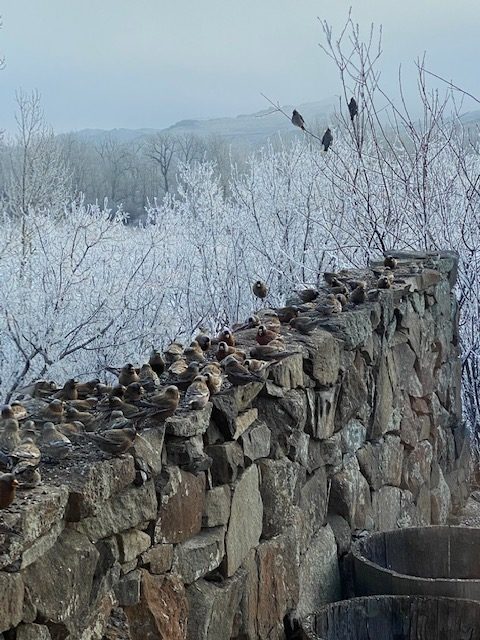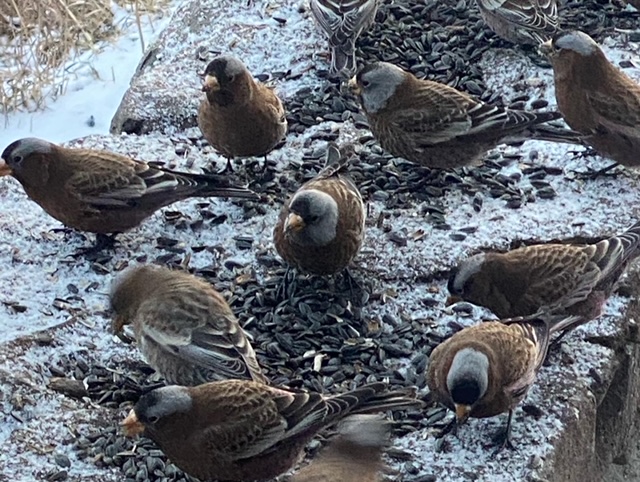The Finches of Cloudland: A Charm of Finches
By Dr. Lynne Spriggs O’Connor
Charm: 1) the power or quality of giving delight or arousing admiration
2) a group of finches
The human condition feels as challenging today as I can ever remember in my sixty-one years of life. The good fortune my husband and I have in spending five months of each year with hundreds of Gray-crowned Rosy-Finches is a remarkable antidote. Our first flock each Halloween numbers at least one hundred and can grow to over four hundred finches by March. Their companionship is profoundly uplifting. The special energy these robust finches impart has everything to do with their movements as a group. We have established feeding times around our own three meals. First, a single sentry may appear. Moments later, in the blink of an eye, the full charm of finches arrives.
The poetry of their murmuration takes our breath away. They swirl and surge in ever-changing patterns. They can pour through the sky like a cascading river. In a flash their dancing bird-cloud can split itself in two, swelling in opposite directions. Just as suddenly, two soaring halves draw back to the whole in the safety of a high cottonwood tree. We revel in the wonder of this spectacle over coffee each morning. For us, these rare finches carry a magnificence beyond words.

To observe daily movements and habits also provides clues about why flocking is so important. In our over-fifteen winters with Gray-crowned Rosies, we have come to appreciate just how difficult their own lives are. Natural predators in our isolated northeastern Montana valley include sharp-shinned hawks, cooper’s hawks, and merlin falcons. When our finches disappear, we ask why. We’re on the lookout as they are, wired to sense these dangers. We’ve witnessed brutal attacks. Out of sight and near the ground, we once saw a sharp-shinned dart upward and around the lower corner of a rock wall for a surprise strike. When a raptor is successful, only a few cinnamon and rose feathers are left in its wake. On three separate occasions, wondering what might have caused the flock’s disappearance, we discovered a Northern Shrike perched near feeders. This white songbird with bandit eyes and a raptor’s habits is ominous. It will sit in plain sight for a long time before leaving. Even then, time must pass before finches will reappear.
This year our Gray-crowned Rosy-Finches feed with a group of over one hundred common redpolls. A capricious magpie will do ‘fly-bys’ like a menacing raptor and cause feeding birds to lift. When twenty magpies decide it’s their turn to feed, smaller birds stay away. Once, I saw a magpie swoop in as a predator to take advantage of an injured GCRF sitting still and alone on cold ground. The finch lifted at the last second and escaped.
These high-altitude finches also live with challenging weather conditions, including bitter cold and fierce winds. Montanans will tell you: Wind was born here. It is not uncommon for Chinook winds in our valley to bring gusts from fifty to seventy miles per hour. Occasionally, they have gusted up to one hundred miles per hour. French doors leading to a courtyard have been ripped out of place – hinges pulled loose, glass panes popped from wooden framing. Yet on days with impossible winds, a high of minus twenty degrees, windchills of minus forty degrees, even in whiteout blizzard conditions, these powerful finches somehow battle the odds and return to feed.
The consequences of rising temperatures for these cold-weather friends are not encouraging. As lower altitude species move up an “escalator to extinction” with the growing effects of climate change, high-altitude nesters like GCRFs are increasingly threatened. Thus far, I’ve not witnessed any signs of bird diseases or parasites in our mountain valley. Birds must also contend with window strikes. What combination of challenges will push these intrepid finches over the edge?
Our separate fates are intertwined. We share a single habitat. The unity of many becomes an allegory of survival. Gray-crowned Rosy-Finches are experts at conjuring fierce energy and intelligence, even – and especially – when weathering the most difficult of circumstances. It is impossible not to feel inspired by daily examples of their resilience and perseverance. When spring arrives, no matter what they must face, our large charm of Gray-crowned Rosy-Finches will join others and head back to inhabit the highest northern peaks of North America – Glacier Park, Denali, the Aleutian Islands – where they will confront truly extreme conditions and nest once again.

Dr. Lynne Spriggs O’Connor is a writer and rancher. She has written several blogs here for FiRN named Finches of Cloudland, and her upcoming memoir is titled Elk Love: A Montana Memoir, where she writes about her special relationship with the Rosy-Finches that have visited her and her husband over the years.
FiRN is a nonprofit, and has been granted 501c3 status. FiRN is committed to researching and protecting these birds and threatened finch species like the Evening Grosbeak, a species that has declined 92% since 1970. We are actively in the process of fundraising around an Evening Grosbeak Road to Recovery plan in addition to a student research project, so please think about supporting our efforts and making a small donation at the donate link below.


